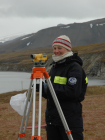S.J. Dresscher, MA

Surviving off the land and sea: understanding the expansion of European commercial hunting systems into the High Arctic – a case-study of Pomors on Spitsbergen (18th – first half 19th century)
This PhD project deals with the Russian Pomor hunting activities on Spitsbergen during the 18th and 19th century. The focus lies on the way they lived and worked under Arctic circumstances. In order to understand this it is necessary to look into the subsistence strategy as well as their commercial activities. The Pomor hunting systems in Spitsbergen transcends this divide between subsistence and commercial hunting. This creates many new and interesting research questions. On the one hand, it is clear that Pomor groups were sent to Spitsbergen to make a profit by obtaining valuable resources. They needed to organise their activities throughout the annual cycle to make this possible. But on the other hand, these groups also needed to survive the extreme conditions of the High Arctic, and to ‘live off the land and sea’ as well as to make a profit. This would have generated many tensions between the motivations to survive but also to be commercially successful. Understanding exactly how and why Pomor groups solved these basic problems is the main goal of the PhD project.
Decomposing textile in old whaler graves due to permafrost melt
GRAVE-PERMAFROST
Recent excavations of 17th and 18th-century whalers’ graves on Svalbard show a
disappointing amount of textile remains being preserved in the permafrost. This was completely different in 1981, when the Arctic Centre of the University of Groningen studied 50 graves at Utkiken (Ytre Norskoya) and found well-preserved wool and silk. In a recent dissertation, Comis (2017) concludes that cotton and linen was already degraded when excavating in 1981. Due to climate change, the permafrost is thawing. We hypothesize that the last textile remains are disappearing and that this process is more pronounced near the eroding coast, at the sites of the most recent excavations. Therefore, we want to investigate hydrology and permafrost in the grave field of Utkiken to assess the possibility of more intact clothing in the entire cemetery. This can be done by scanning and ground-penetrating radar techniques. If possible we will use drones to minimize our footprint. If successful, this technique could also be used in other cemeteries and create a management strategy for this type of cultural heritage. In combination with this field campaign, we also plan an experimental decomposition study on different textiles material in relation to their position in the soil.
| Last modified: | 04 August 2023 07.48 a.m. |
